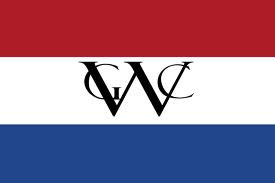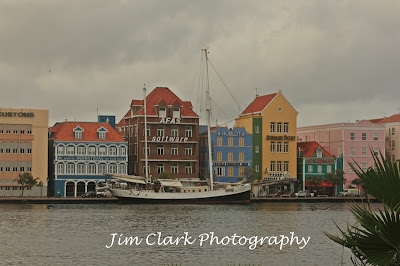Curacao is an island in the Caribbean where the international trade routes of the Atlantic Ocean meet. Willemstad the capital, was built around a superb harbour which was formed more than 10,000 years ago.
Willemstad harbour entrance.
Curacao was probably first inhabited some two thousand years ago by Arawak Indians who came over from South America. By the time the Spaniards arrived in 1499 there were an estimated 2,000 Indians on Curacao.
The Dutch West India Company saw Curacao as a potentially valuable base in the Caribbean, and in 1634 the Dutch took over the island. There was little resistance as there were only 32 Spaniards on the island, of which 10 were children. Along with most of the Indians, they were deported to the mainland. Under the Dutch West India Company, Curacao became a centre of trade. The town was built with a harbour open to all commerce, including private traders.
Dutch West India Company flag.
Willemstad grew between 1676 and 1732 and was to remain practically unchanged until 1860. Willemstad's harbour area formed a melting pot of cultures. Seafarers from every corner of the globe gathered here. Crews were paid off after each voyage. It was then up to the men to look after themselves until they could find a new ship. Many seamen lived on Curacao and most were either slaves or freed slaves. Curacao became the main base for Dutch privateers. The prosperity of the island owed much to these privateers. Moreover, they provided an essential protection against attacks by enemy privateers.
Between 1670 and 1815 Curacao was the centre of the Dutch slave trade. Thousands of Africans were transported here to work on the plantations of South America and the Caribbean islands.
A lively illicit trade with the Spanish colonials on the mainland developed in Curacao. Spain's colonies were isolated. Officially, they were only allowed to trade with Spaniards, but the links with the Spanish fleet were tenuous. Consequently, there was a constant shortage of slaves, European goods and customers for products. The illicit trade with the Dutch Republic was more than welcome. In the eighteenth century, the trade grew to such an extent that Venezuela became economically dependent on Curacao. A situation that continued into the nineteenth century.
Between 1650 and 1670, Britain was regularly at loggerheads with the Dutch. Curacao’s monopoly in the slave trade was especially irritating to the British. Once they had chased the Dutch out of New York in 1665, the British focused their attention on Curacao. They commissioned privateers to do their dirty work. From 1800 to 1803 and from 1807 to 1816 Curacao was administered by the British. The Dutch regained the island in 1816.
Trade stagnated worldwide in the years 1800-1840. Willemstad harbour found itself becalmed. In 1827 in an attempt to attract trade, Willemstad was declared a free port, with no taxes or excise.
The harbour’s fortunes gradually revived in the 1840s. In the 1860s the tide turned. Trade and shipping increased considerably. By 1900, Willemstad was a lively commercial centre with thoroughly modern facilities. Shipbuilding flourished between 1840 and 1890. Curacao shipbuilders were especially noted for their schooners. Their size and solid construction made these vessels ideal for the ocean traffic to America and Europe.
A regular packet service between Europe and Curacao became available in the nineteenth century. In 1827-1829, the paddle steamer Curacao was introduced. It was something of a gamble, since steam was still in its infancy. Moreover, the Curacao was a rather small vessel for ocean travel. The Curacao was the first steamship to cross the Atlantic Ocean. It made the voyage in 28 days; sailing ships took forty days to cross.
Steamship Curacao.
However, after three voyages beset with problems, the experiment was dropped. In 1882, an Amsterdam, New York and Curacao line was established. Connections with Curacao improved dramatically and Curacao became a major focal point, not least since Curacao was the first port of call for many European ships crossing the Atlantic. By 1910 around 25 steamers were entering the harbour each month on regular lines from seven different countries.
By 1939, Curacao was the world's seventh busiest harbour. The peak came in 1952. In the years that followed the transit port function gradually declined. From 1910, motorized ships ran increasingly on oil rather than coal. Curacao was quick to take advantage. There was nowhere in the Caribbean to compete with the speed and price at Curacao. Between 1914 and 1930 Willemstad became a major fuelling station.
Prinzessin Victoria Luise.
In 1901 the first cruise ship arrived. It was the Prinzessin Victoria Luise from New York. With the attractive prices of the products in its shops, Curacao developed into a popular destination for cruise ships. Not all the cruise ships moored in the harbour. The narrow entrance kept many vessels away. They simply anchored offshore.
Cruise ships today outside the harbour.
Modern day cruise ship outside the harbour.
On 31 July 1914, oil was discovered at the Lake of Maracaibo in Venezuela. The Royal Shell Oil Company choose Curacao as its base. The most important reason was the broad and deep natural harbour. Between 1918 and 1924 a refinery was built with its own wharves in Schottegat. Oil became the engine of Curacao’s economy. In 1914, the Panama Canal opened. Curacao prepared itself for a flood of trade. However, the expectations did not materialize. It was the oil industry, rather than the Panama Canal that kept Curacao’s economy afloat.
Many cruise ships now access the quayside within the harbour.
One of the larger modern day cruise ships in Willemstad.
During the Second World War, the Curacao oil industry flourished as never before. The Allied forces in North Africa depended entirely on fuel, known as 'Navy Special' supplied by the refineries on Curacao and Aruba. Because of their strategic involvement they became military targets. In December 1941, the United States began reinforcing their position in the Caribbean. The Royal Dutch Navy and the Antilles forces were placed under command of the Americans and American troops were stationed on Curacao. The Americans were to remain on the island until 1947, when the Dutch administration returned. Since 1950, the defence of the Antilles has been entirely in the hands of the Royal Dutch Navy.
Merchant vessel entering harbour - floating bridge open.
The early 1980s saw a decline in demand for oil. Shell made drastic cuts. Finally, in 1985 the company sold the refinery for a nominal one guilder to Curacao. The steady decline of the oil industry was a heavy blow to the economy of the island. Now, the refinery is leased by Petroleos de Venezuela S.A.
Arriving in Willemstad today is like stepping into a children's picture book, with each of the buildings painted an ice-cream colour. In the historic centre of the town, the architecture is unmistakably Dutch.
All the plantation houses have visual contact with at least two others. This is in case of any slave uprising or other emergency, where they would signal each other with lights.
The floating pontoon bridge.
Pontoon bridge.
Between both sides of the harbour entrance is a floating pontoon bridge. The pontoon bridge is made up of 16 boats. In days gone by, you could cross the bridge for free if didn’t wear shoes. With shoes on you had to pay!
The Curacao flag represents the blue sky and sea which is separated by the yellow sun. The two stars represent the island of Curacao and her uninhabited sister island “Klein Curacao”, the 5 points on the stars represents the 5 continents where local inhabitants are from.
In 2010 Curacao became an independent country after the Netherland Antilles was dissolved. However, Curacao remains within the Kingdom of Netherlands, which continues to oversee financial and defence matters.























No comments:
Post a Comment